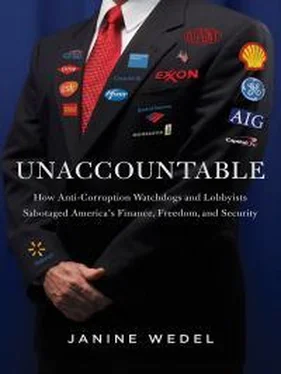McConnell has swooped back and forth in swift succession, with one or more roles shoring up his own power and influence, as well as those of his associates, in the next. From 2005 to 2007, while at Booz Allen, he chaired the Intelligence and National Security Alliance (INSA). That industry association later cited its mission as: 23
[providing] the intelligence and national security communities with a non-partisan catalyst for public-private partnerships which identify, develop and promote creative solutions through access to committed experts in and out of government.
With one hundred and fifty corporate members and several hundred individual ones, including many former senior intelligence officials and influential academics, INSA’s championing of public-private partnerships promotes the move toward the privatization of intelligence and serves CIA and NSA contractors. 24
The prevailing national feeling of the post–9/11 period, of course, was fear and, on the government’s part, the need to protect the populace. McConnell was well placed at the time. In late 2002, he deployed his government connections to secure business for Booz Allen, 25as well as to help ramp up a vast “surveillance state,” according to Shane Harris, author of The Watchers: The Rise of America’s Surveillance State . McConnell helped Admiral John Poindexter, then working in the Pentagon for the Defense Advanced Research Projects Agency (DARPA), to sell and set up the Orwellian, reportedly short-lived, “Total Information Awareness” surveillance program: 26
. . . McConnell was prepared to provide “top cover” by talking to senior members [of Congress] and committee staff about TIA. . . . [He] could broach the subject of surveillance laws and regulations with far more credibility and less drama than Poindexter. He had enjoyed an impeccable Navy career, and his name counted for a lot in Washington, particularly among senior members of the Bush administration. He could clear Poindexter’s path. . . . But McConnell didn’t want to stop there. He told Poindexter that he should award Booz the entire TIA contract, letting the company effectively take over the research, testing, and construction of the prototype, a soup-to-nuts arrangement.
McConnell had to settle for a smaller role, a contract of around $8 million, which would still tap into his government connections: as Harris puts it, “Booz . . . would get TIA out of the lab and into the hands of government users . . . McConnell would spread it around. His connections, and those of his company, would pay off after all.” 27
Indeed they did. In 2007, as mentioned, he was tapped as DNI. The issue was not whether, but when, McConnell would return to DNI, according to Harris. 28As Harris tells it, McConnell worried that his “ability” (read: power) as DNI would be “limited.” His concerns were abated when he realized he would be surrounded by allies, including “longtime friend” retired Air Force Lieutenant General James R. Clapper, Jr., who also had worked at Booz Allen and who later hired the contractor while he was the head of the National Geospatial-Intelligence Agency: “The proverbial stars had aligned,” writes Harris. “[Then-Defense Secretary Robert] Gates at the Pentagon, ready to help. Clapper coming back [as Gates’s intelligence chief]. [Retired Air Force General Michael] Hayden, a former NSA director and a friend now in charge at the CIA.” Harris reports that McConnell spoke with both Clapper and Gates to ensure their support of himself and his goals. 29
Glenn Greenwald, in his 2010 takedown, took aim at McConnell for his activities as DNI, calling him “a perfect symbol for the legalized corruption that dominates Washington” and detailing his efforts to grow intelligence outsourcing: 30
As Bush’s DNI, McConnell dramatically expanded the extent to which intelligence functions were outsourced to the same private industry that he long represented. Worse, he became the leading spokesman for demanding full immunity for lawbreaking telecoms for their participation in Bush’s illegal NSA programs—in other words, he exploited “national security” claims and his position as DNI to win the dismissal of lawsuits against the very lawbreaking industry he represented as INSA Chairman, including, almost certainly, Booz Allen itself. Having exploited his position as DNI to lavishly reward and protect the private intelligence industry, he then returns to its loving arms to receive from them lavish personal rewards of his own. 31
McConnell was DNI for only two years before leaving for . . . Booz Allen in 2009 “to lead the firm’s Intelligence business,” states the company’s website, as an executive vice president. Two years later, he was promoted to his current position as Booz Allen’s vice chairman. 32
And just who was deemed most suited to take over as DNI from McConnell? Why, McConnell’s friend and Booz Allen stalwart, James R. Clapper. His career path mirrors that of McConnell’s. After “retiring” from the military in 1995, Clapper worked at Booz Allen and the government contractor SRA International until 9/11, when he returned to government as head of the National Geospatial-Intelligence Agency. 33Journalist Ken Dilanian, who has connected some of the dots of Clapper’s many and lucrative private-sector postings, details his moves after leaving that government perch in 2006: 34
Four months after James R. Clapper left his federal job as head of the National Geospatial-Intelligence Agency in June 2006, he joined the boards of three government contractors, two of which had been doing business with his agency while he was there. . . . In October 2006 he was hired full-time by DFI International, which was trying to boost its consulting with intelligence agencies. In April 2007, when he returned to public service as the chief of the Pentagon’s intelligence programs, DFI paid him a $50,000 bonus on his way out the door, according to his financial disclosure statement. Five months later, DFI landed a contract to advise Clapper’s Pentagon office, though company officials do not recall collecting any revenue from the deal.
Let me point out that the selection of contractors in certain areas is made complex by the notable consolidation of defense companies in recent years and by the fact that, in certain areas of contract “competition,” there can be little competition because very few companies meet the specific requirements of a given contract. Still, how can the public feel confident that Clapper’s office made that choice of contractor for the right reasons? A former DFI official didn’t exactly inspire faith in his recollection of the facts when he told Dilanian “I am almost positive we never saw a dime of work out of this.” The White House insisted Clapper wasn’t directly involved in selecting DFI, and, as is often the case, cited his decades in the military as a sort of all-purpose defense of his integrity. 35
Looking at this case involving DFI shouldn’t detract us from the larger picture of Clapper, McConnell, and their allies and their broader push to enhance both their own power and their promotion of contractors to carry out sensitive intelligence work. Like McConnell, Clapper, after five years of working in the contractor world, agitated for enlarging the outsourcing of intelligence. As journalist Tim Shorrock, author of Spies for Hire: The Secret World of Intelligence Outsourcing , wrote in the New York Times : 36
In 2000, thanks in part to an advisory committee led by James R. Clapper Jr. . . . the N.S.A. decided to shift away from its in-house development strategy and outsource on a huge scale. The N.S.A.’s headquarters began filling with contractors working for Booz Allen and hundreds of other companies.
And in 2010 confirmation hearings before the Senate Intelligence Committee, Clapper expressed goals similar to McConnell’s. He signaled that he would seek to shore up the clout of the DNI and “push the envelope” to deepen the authority of the intelligence head. 37
Читать дальше












